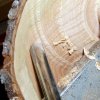When I am teaching a begining turning class I teach the students about tool rest height. This is a very important part of turning. If set to the wrong height you will incure catches, gouges, poor cutting and, lack of tool control. When turning on the outside of a piece, as in spindle or outside a bowl or box, to set the rest so the cutting edge of the tool being use is at or just below center line of the axis. This is done so if the tool should catch it will be pushed away from the wood. If the cutting edge is above center line when you get a catch then the tool is pulled into the wood causing much damage.
When cutting on the inside of a piece as in the inside of a bowl, box or hollow form the rest should be set so the cutting edge is slightly above the center line. Again, if the tool catches it will be pushed away from the wood.



